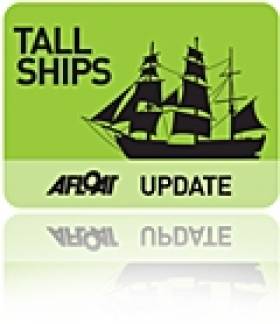Displaying items by tag: Sail Training International
#tallship – With St Patrick's Day almost upon us, the westward trek across the Atlantic in search of American benevolence and funding for worthy objectives can become a very crowded pilgrimage. Among those looking for meaningful support for their pet projects, there will likely be proponents of some sort of new Tall Ship to replace the much-mourned brigantine Asgard II, and the ketch Lord Rank, both of which foundered in 2008 to leave Ireland - north and south alike - bereft of national sail training vessels.
Since then, there have been re-groupings of those who support the admirable concept of sail training for young people. In all, there may be as many as five different bodies on the island of Ireland which now provide access to the international programme. Coiste an Asgard itself was wound up in 2011, but it was immediately re-born as the Dublin-headquartered Sail Training Ireland, the national authority which carries the imprimatur of Sail Training International, the global body which co-ordinates and regulates all sail training.
The other main organisation, often functioning in tandem with Sail Training Ireland, is the Atlantic Youth Trust. It has offices in both Dun Laoghaire and Belfast, and has as its primary objective the construction and commissioning – for all Ireland – of a Class A 40-metre three-masted barquentine. WM Nixon continues with the story.
When we carried a history and analysis of Ireland's involvement with the International Tall Ship and Sail Training movement on this site on January 17th, the immediate response was formidable, and in favour. It continues to register hits at a rate which shows that the maritime community in Ireland has a real wish to see our own proper tall ship.
To achieve this ambition, in terms of having a clearly outlined plan the Atlantic Youth Trust is way ahead. With leading personnel from many parts of Ireland on its high-powered board of Trustees and Directors, the concept - originally inspired by Enda O'Coineen and John Killeen of Galway – is already becoming very complete.
Executive Director Neil O'Hagan and other have researched globally in order to analyse the success of more than two dozen national sail training schemes, and they have concluded that the best model to learn from is the Spirit of Adventure Trust in New Zealand, which functions through training based around the barquentine Spirit of New Zealand, which at 45.2 metres in "sparred length" is steel built registering at 184 gross tons, and carries 40 trainees.
The funding concept on the capital outlay for building the new ship for Ireland will ultimately rely on a total of €15 million being put up jointly by the two governments in the interests of inter-community and cross-border co-operation. Although the current turmoil in the Northern Ireland political administration might temporarily impair the onward progress of the plan, it seems to have a certain inevitable momentum, and highly-regarded Netherlands-based Dykstra Naval Architects have been retained on the project, as have their associates at Damen Shipyards, who may supply the vessel in flatpack form for final construction in Ireland.
As to running costs, the AYT point out that it will come out of current spending, as the vessel by nature of its work will be able to tap into government funds for social welfare and other youth schemes.
Faced with such a juggernaut of ideas, energy, contacts at top government level, and sheer enthusiasm, it seems churlish to question the validity of what is, after all is said and done, a magnificent project. But there are many in Irish sailing in general and sail training in particular who are concerned about the thinking on which it is all based.
To begin with, while we all admire the maritime spirit of New Zealand, does it make sense to draw conclusions for Ireland from a successful scheme in what is essentially a very isolated island nation? Ireland may be an island nation, but it's clearly wide of the mark to describe us as isolated, and this is reflected in the pattern of tall ships visit. If just six tall ships turn up at one port in New Zealand, it's regarded as a major event. But if less than sixty tall ships turn up at this year's Tall Ships Festival in Belfast at the beginning of July, then it will be regarded as a non-event.
In other words, Spirit of New Zealand usually functions in relative isolation, so it is not sail training as we know it in Europe. In fact, she is more of a floating school cum boot camp which happens to set sails, and in order to keep her very numerous trainee complement of 40 busy, while cruising in New Zealand waters (which she does nearly all the time), she is escorted by a large rib which frequently conveys the trainees ashore for land-bound ventures which sometimes out-balance their sea time.
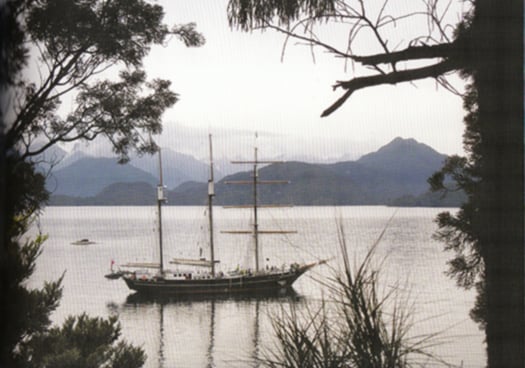
Alone, all alone.....the Spirit of New Zealand in a remote inlet on New Zealand's South Island. With forty trainees and a relatively easily-handled rig, she has a programme whch includes much shoreside activity. Photo courtesy STI
It's a very attractive programme in the New Zealand context, as they have many remote coastal areas which are virtually uninhabited and ripe for shore adventures which will not conflict with the rights of local inhabitants. But in Ireland and much of Europe such a programme would immediately meet problems, and for Ireland it makes more sense to follow the European pattern which puts an almost total emphasis on voyaging and sail training races.
Were a heavily-crewed vessel such as Spirit of New Zealand to do the European programme, there simply wouldn't be enough work for the 20 trainees on each watch to keep them happily occupied for long periods. Ideally, trainee tall ships are extremely labour-intensive for all hands, and in Europe that's the way it is done, but it needs what amounts to individual attention for each trainee.
So it's difficult to escape the conclusion that one reason for the attraction of the New Zealand scheme for the Atlantic Youth Trust is that it wins out in the numbers game. Forty young people taken out of troubled and aimless environments ashore, and sent away together on a voyage, is an impressive amount of social problems temporarily sorted in one fell swoop.
But will it be as behaviourally beneficial, in the long term, as it would be for a smaller number of people on a smaller and busier vessel? It will vary from case to case, but generally you'd reckon that the smaller more personal crew setup, with each trainee more directly involved in the sailing of the ship, would produce better results, while always remember that having as much square rig as possible is central to the concept.
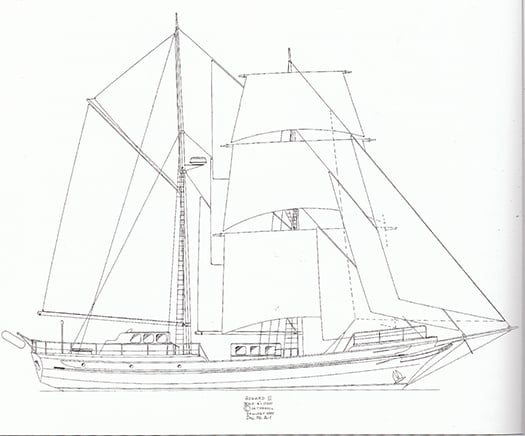
A timeless design which remains a very viable proposition for an easily managed ship which keeps her crew busy. Jack Tyrell's lines for Asgard II would lend themselves to construction in steel or even aluminium.
Ideally, to see Ireland's Tall Ship-owning reputation restored, many of us would like to see not just one newly-built replica of the 84ft brigantine Asgard II being launched, but three – one each for Cork, Dublin and Belfast. For, at the moment, the main axis of Atlantic Youth Trust activity seems to be between Dublin and Belfast. Yet as last weekend's National Annual Sailing Awards ceremony in Dublin so clearly underlined, Cork is really where it's at in terms of maritime development, and the lack of a significant Cork element seems to be a weakness of the AYT scheme.
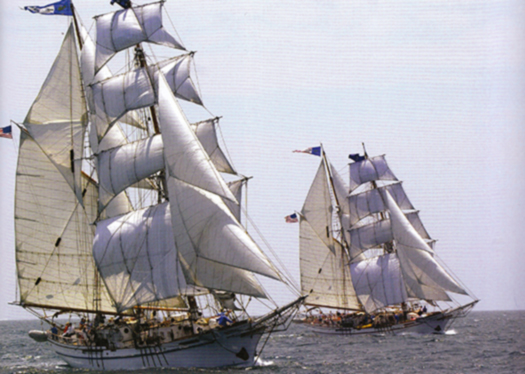
Might this be the way forward? One of our suggestions today is that Ireland really needs three Asgard IIs, based in Cork, Dublin and Belfast. We get an idea of how it might look with the two sister-ship American brigantines Exy Johnson and Irving Johnson, which are based in Los Angeles in California, where they were built in 2002.
Nevertheless, it says much for the dedication and energy of those promoting the Atlantic Youth Trust that we have the luxury of debating the validity of their plans, which have been so thoroughly developed. We may disagree with their conclusion, but it's not total disagreement – an Irish version of Spirit of New Zealand would be a very emphatic improvement on our present ship-less state, which is too much of a reflection of an ancient and negative mind-set.
Every time you see the Tall Ships gather and see how maritime countries of population comparable to Ireland, such as Norway, Denmark and Portugal, can send forth spectacularly handsome Tall Ships, it becomes a painful reminder of how the new Irish Free State increasingly turned its back on the sea.
The fact was admitted by Minister for the Marine Simon Coveney at last week's National Sailing Awards Ceremony in a speech which hinted at some very significant developments in the Irish maritime sphere in the near future.
But really, what Minister Coveney was talking about is that it is time and more for us to grow up in our attitude to the sea. When the Free State was struggling into being in 1922, the popular view was that British power was synonymous with sea power. So if you were against the sea and seafaring in all its manifestations, then you were demonstrating the purity of your patriotism through adopting what was essentially if subconsciously an anti-British stance. Childish perhaps. But we all know that's the way it was.
So despite the flurry of maritime enthusiasm which was engendered by national emergency during World War II to inspire the creation of Irish Shipping and the Maritime Inscription, what this meant was that when the underlying attitude genuinely began to change in the 1950s, a positive attitude towards the sea wasn't being built upwards from Ground Zero. It was being built from Ground Minus Thirty – the number of years that an anti-maritime attitude had been the unstated yet very real official policy.
Thus there was a period when Irish maritime enthusiasm had to be kept going almost as a secret cult, and I'd an odd reminder of this some weeks back at the annual Awards Ceremony of Sail Training Ireland. The Patron of STI is President Higgins, and the event was held – for the second year running – in the Mansion House in Dublin. Yet the very fact of the identity of their Patron, and of their event being staged in the Mansion House in the presence of Lord Mayor Christy Burke, provided such pleasure and pride for everyone in the gathering that it was a forceful reminder that, not so very long ago, seafaring was very much the poor relation in Ireland, and there were those in authority who would have happily air-brushed it out of the national picture entirely, leaving it to foreign crews to undertake the rough trades of the sea.
But thanks to those former members of Coiste an Asgard who refused to give up the vision of sail training for Ireland, even as the onset of economic Armageddon from 2008 to 2011 made any prospect of a new Asgard II a very distant vision as the government chucked the €3.8 million insurance payout into the bottomless pit of national debut, Sail Training Ireland arose like a Phoenix and set in place sail training bursaries for places on foreign tall ships, using international contacts built up during the 27 successful Asgard II years to ensure that Ireland could re-build our position at the heart of the movement.
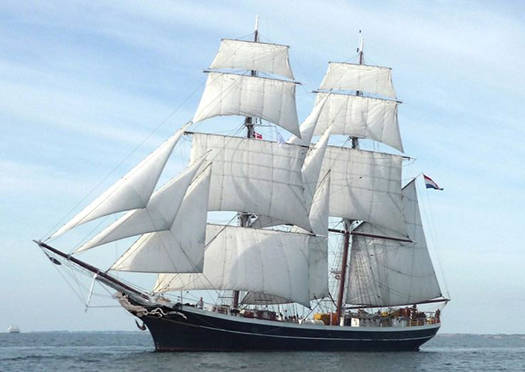
She keeps them busy....the Dutch brig Morgenster is superbly labour-intensive in the best sail training traditions. Photo courtesy STI
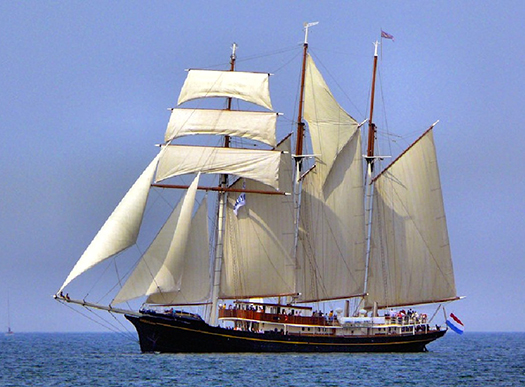
Gulden Leeuw is another of the Dutch Tall Ships which have been taking Irish trainees to sea on Sail Training International programmes. Photo: Courtesy STI
The thriving tall ships scene in the Netherlands – which has become a focal point for sail training and the Tall Ships industry for all Europe – proved the most fruitful placement area, with most Irish trainees being positioned aboard the very handsome 48 m (sparred length) brig Morgenster, which has become a familiar sight in Irish ports. Another ship well used is the three-masted topsail schooner Gulden Leeuw, a long slim craft as she is 70 m in sparred length, while that noted poster girl of Tall Ships sailing, the 56 metre three masted Dutch barque Europa, also carried Irish crew from time to time.
However, while placements on such vessels work very well, the hankering for an Irish sail training flagship is always there, and fortunately in recent years Oliver Hart's 70ft training schooner Spirit of Oysterhaven has been punching way above her weight in filling the role in gallant style with a varied programme on the Irish coast.
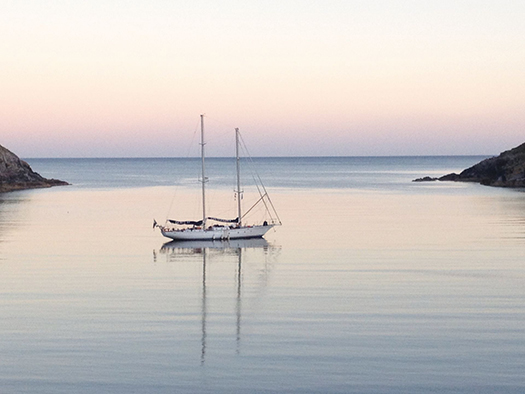
Spirit of Oysterhaven in South Harbour, Cape Clear Photo: Oliver Hart
This and much more was reflected in the Sail Training Ireland Awards Ceremony in the Mansion House, a goodly gathering which was representative not just of every possible aspect of sail training at home and abroad, but also of Irish ports which are increasingly interested in an activity which brings their ancient waterfronts vividly to life. And the progress of various ship projects was spoken for by everything from complete vessels such as the Basque Spanish schooner Atyla represented by Rodrigo de la Serna, through vessels in the making as personified by our own ketch Ilen. She has since seen her final new plank knocked ceremonially into place at Oldcourt in Baltimore, but here's an evocative video Gary MacMahon left with us of the creative planking process under way. And present too was Neil O'Hagan of Atlantic Youth Trust, whose organisation deservedly received recognition for their pioneering work towards a completely new ship.
{youtube}ZLT3D8TBbwk{/youtube}
The main awards presented in the Mansion House by STI Chairman Seamus McLoughlin, who is former Head of Operations for Dublin Port, were:
1. Trainee of the year: Andrew Crowley
2. Special Contribution Award: Turlough Kennedy
3. Special Achievement Award: Fiona Armson
4. Perpetual Asgard Award: For an outstanding contribution to, or achievement in Sail Training by an individual or group: Atlantic Youth Trust / Foroige Group of Trainees
5. Watch-leader of the Year: Sara Mason
6. Volunteer of the year: Jonathan O'Brien
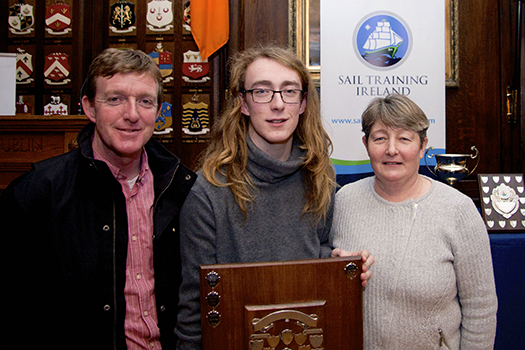
Trainee of the Year Andrew Crowley with his parents in the Mansion House
Trainee of the Year Award: Andrew Crowley
Andrew is Club Captain of the Spirit of Oysterhaven Trust. During 2014, he was instrumental in helping to organise the Club's sailing trips aboard Spirit of Oysterhaven with a special emphasis on providing opportunities for young people with disability. He helped to organise the Club's Youth in Action programme, and crewed aboard Spirit during the Irish Cruising Club's sponsored Anniversary voyage from Glandore to Glengariff with a crew of eight trainees, including several with disability. During the summer Andrew was a vital member of a short-handed crew delivering Spirit from Oysterhaven to Glandore during which he proved himself an outstanding active crew member.
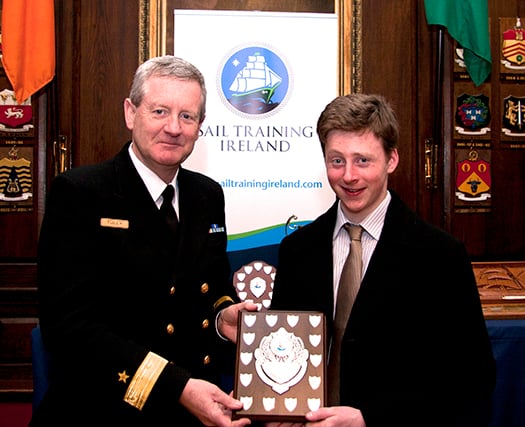
Commodore Hugh Tully, Flag Officer Commanding Naval Service, with Turlough Kennedy, who received the Special Contribution Award
Special Contribution Award: Turlough Kennedy
This year's special contribution award goes to Turlough Kennedy from the lakeside port of Scarriff in County Clare for the outstanding role he filled on the Dutch tall ship Morgenster.
To quote Michael Byrne, Director of Sail Training Ireland: "This contribution was not only recognised by us. On completion of last year's voyage Turlough - despite his limited sea going experience - was offered a crew member's berth on board the ship by the Captain. While he was not in a position last year to take up this offer for the remainder of the 2014 season, in 2015 we are delighted that Turlough will be sailing as voluntary crew on board the Morgenster. The following is a short note from the ship's Captain, Harry Muter: "Turlough sailed with us last year and he was very good good both in the sailing department as in the social processes. For his age he was surprisingly adult, patient and emphatic. And then the music, it coloured this voyage, and Turlough played a role with his complicated bagpipe and improvisation talent. Looking forward to sail with him again." " (There are no prizes for guessing that "complicated bagpipes" are Uileann Pipes).
Special Achievement Award: Fiona Armson
The special achievement award this year went to Fiona Armson for the tenacity and determination she showed by completing her 14 day voyage. Fiona found some aspects of life at sea a real challenge but despite being given several opportunities by her leaders and the crew to take on a lighter work load Fiona refused to leave her watch and pushed on.
Fiona completed her voyage having never missed a single watch or duty and, in a way that would put a smile on any sailor's face, she sailed the Gulden Leeuw into her home port of Bangor.
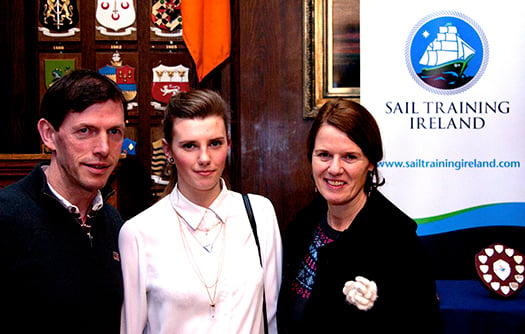
Special Achievement Award Winner Fiona Armson with her parents
Perpetual Asgard Award
Awarded to a group of four Foroige Trainees: Michael Collins, Dean Mc Keon, Brandon McDonagh, and Daniel O'Halloran,
In March 2014, four young people from Ballybane in Galway set out on a remarkable adventure, travelling half way around the world to experience the Spirit of Adventure's 10-Day Youth Development Voyage in New Zealand. Three youth workers accompanied the group for the three week trip, and one of them, Pearse O'Toole, was at the Mansion House with them. The trip was funded by a private donation and managed by the Atlantic Youth Trust and Foroige.
The group spent 10-days sailing around the magnificent Hauraki Gulf off Auckland on the barquentine Spirit of New Zealand. They adapted very well to their new surroundings as crew members and returned with fresh skills, more confidence than ever, and a new outlook on life and what is possible.
Neil O'Hagan, Executive Director of the Atlantic Youth Trust, followed this award with a presentation about the Peace and Reconciliation Fund-supported Sea-Connections scheme, and then the next award was remarkably appropriate, as it was for the Watch Leader of the Year and it went to Sara Mason for her very successful participation in an EU Youth Exchange Voyage on Gulden Leeuw.
Sara (pronounced saarah) is from the North Island of New Zealand, but now lives and studies in Dublin. She is part of the Shackleton Outdoor Adventure Management Diploma Course in Colaiste Dhulaigh in Coolock. She joined the team of youth leaders which facilitated the main voyage programme of Youth Exchange projects in May-June. As a leader on the Dutch Ship Gulden Leeuw, she cared for and facilitated a group of 40 young adults over a 14 day period. She was an outstanding support to them as a leader, and brought with her a set of skills that are unique to professionals who spend their lives working with people in the outdoor adventure industry. She also has a fantastic energy and enthusiasm and was an inspiration to the trainees and other leaders.
Volunteer of the Year Award - Jonathan O'Brien
Jonathan has become involved in a multitude of voluntary activities with Sail Training Ireland in the last year. In 2013 he volunteered as a youth leader for one of STI's youth exchange voyages for 10 days from Belfast to Dublin. In 2014 he was head-leader across youth exchange voyages with a total of 8 leaders, with at times up to 100 trainees across three ships seeking his support.
Having a background in both outdoor education and in social care, Jonathan has an exceptional set of skills that lend themselves very well to the role of leader on a tall ship, and he has now found himself "volunteered" for a position on STI's sub-committee for trainee programmes. During 2014, he also spent time on a number of ships across Europe, while somehow also fitting in a spell serving as First Mate on the Spirit of Oysterhaven. He is helping to develop on-board programmes for a number of STI's funded voyage schemes during 2015, and will also train STI's group of twelve youth leaders in April.
So the good work goes on, but the more of it there is, the more it become apparent that Ireland needs her own tall ship, and the sooner the better. A programme of international placement may work very well for those in the know, but for people down the country which are remote from maritime communities, it often takes the stimulus and sense of pride engendered by an Irish ship to make that first move afloat.
It was summed up so well by investigative academic and journalist Dr Elaine Byrne in our story about the Tall Ships on January 17th that it deserves repeating here. Usually in her line of work, Elaine Byrne takes no prisoners. But the quiet depth of feeling underlying the brief story of how the Byrne family from the deepest rural depths of County Carlow became involved in sail training has a resonance for us all today:
"I'm the oldest of seven children from a farming family on the Carlow/Wicklow border, where the household income is augmented with a funeral undertaking business attached to a pub in which I might still work on visits home. Our background is just about as far as it's possible to be from Ireland's maritime community. Yet thanks to Asgard II, I was able to take a step into the unknown world of the high seas as a trainee on board, and liked it so much that over the years I spent two months in all on board, graduating through the Watch Leader scheme and sailing in the Tall Ships programmes of races and cruises-in-company.
Down in the depths of the country, my new experiences changed the family's perceptions of seafaring. Four of my siblings then had the opportunity to sail on Asgard II. If it were not for Asgard II, my family would never have had the chance to sail, as we did not live near the sea, nor had the financial resources to do so. The Asgard II played a large role in our family life as it became a Rite of Passage to sail on board her. My two youngest siblings did not sail on Asgard II because she sank, which they much regret.
Apart from the discipline of sailing and the adventure of new experiences and countries, the Asgard II brought people of different social class and background together. There are few experiences which can achieve so much during the formative years of young adulthood".
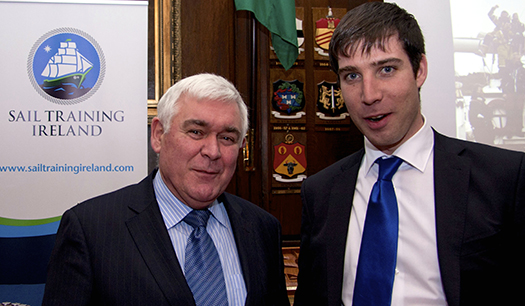
Seamus McLoughlin, Chairman of Sail Training Ireland, with Michael Byrne, Director.

Carolanna Foley, awarded a Drogheda Port Sail Training Bursary, with Seamus McLoughlin (left) and Commodore Hugh Tully
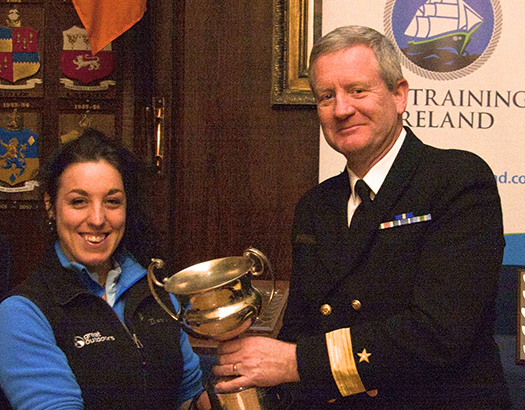
Sara Mason, Watch Leader of the Year, with Commodore Hugh Tully

Jonathan O'Brien (left) Volunteer of the Year, with Oliver Hart
- Sagres
- Tall ship
- Coiste an Asgard
- Atlantic Youth Trust
- barquentine
- Sail Training Ireland
- Sail Training International
- John Killeen
- Enda O'Coineen
- Neil O'Hagan
- Dykstra
- Damen Shipyard
- sailing
- Simon Coveney
- Lord Mayor
- Phoenix
- Spirit of Oysterhaven
- Europa
- Morgenster
- Gulden Leeuw
- Basque Spanish schooner Atyla
- Ilen
- Elaine Byrne
- Oysterhaven
- Mansion House
- Christy Burke
- World War II
'Gift of Youth' Set to Sail into Dublin Bay
#TallShips – This Thursday the tallship Dar Mlodziezy, a fully rigged A class sail-training vessel of the Gdynia Maritime University (a state run Maritime academy) is due to visit Dublin Port for two days, writes Jehan Ashmore.
An English translation of her name means "The Gift of Youth" which is appropriate given that the ship built in 1982 at the Polish city of Gdansk on the Baltic Sea, was completed with funding partly financed by the gifts of young school-children.
Designed by Zygmunt Choren, she is specifically constructed to train cadets of the Polish marine and she has taken part in The Tall Ship Races over the years.
Some of her main specifications are detailed as follows: Length: 110.6 m Beam: 14 m Draught: 6.6m Height of tallest mast 62.1 m Sails: 3.015 sq m Top speed under sail: 17.8 kt and she has a displacement of 2946 tons.
She has a crew of 40 and where cadets that number up to 136 personnel are trained in seamanship skills. Should there be no wind, she is fitted 2 x 750 hp Cegielski-Sulzer engines which generate more than 12 knots.
Given the current spate of strong winds, this however should not pose an issue!
More Big Tallships Due for Start of Dublin’s Sailing Spectacle
#TALLS SHIPS – So far some 30 vessels of the 43 strong-fleet are berthed along the Liffey quays and the remainder of the fleet including some of the largest and most impressive A -class tallships are due tomorrow, writes Jehan Ashmore.
They include the Mexican Navy's sail training barque Cuauhtemoc (built 1982, length: 90m), the full-rigged ship, Amerigo Vespucci (built 1931, length 102m) also used for the same purpose operated by the Italian Navy.
Their arrival tomorrow, will certainly add to the exciting atmosphere as the first of the four-day free family festival begins. The festival is billed as the biggest festival event in Ireland, which is expected to draw an estimated 1 million visitors. An excellent opportunity to see these wonderful ships of sail is by taking the Allianz All-Aboard Liffey Cruise, with seats available for just €1!
One of the festival programme highlights will be the 'Crew Parade' (Friday August 25th), when 1,500 sailors are to walk through the city to a prize giving ceremony.
The weekend will culminate in spectacular fashion with the 'Parade of Sail' (Sunday August 26th) when all the ships leave port together with their graceful sails hoisted. For details of the action packed festival sponsored by the Polish port city of Szczecin and organised by Sail Training International visit: www.dublintallships.ie
It's nearly a week since the final Tall Ships Race leg was completed between Coruna and off Tuskar Rock Lighthouse, albeit in very stormy conditions with torn sails and even broken masts.
Having said that the weather has greatly improved with more sedate seas in which the tallships dispersed to ports Arklow, Dun Loaghaire, Howth, Wicklow and Waterford, last year's host port of the famous race and where in 2006 the crystal city first welcomed the fleet.
In recent days batches of tallships, of all shapes, sizes and classes have descended into Dublin Bay. Larger tallships tended to take a route via the Kish Bank, whereas medium and smaller classes clung along the Leinster coast and some made a transit through Dalkey Sound.
As of this afternoon, the Naval Service L.E. Emer (P21) provided escort duties as several vessels made passage parallel to the east coast and later docked in the cities 'docklands' quarter.
Among the arrivals were:
Danmark (class: A, rig: built: 1933, length: 74m) De Gallant (class B,rig: Gaff Schooner, built 1916, length: 36m) and Challenge Wales (Class C, Rig: Cutter, built: 2000, length: 22m)
The latest arrival came this evening with the Jubilee Sailing Trust's Lord Nelson, she is one of only two such sailing vessels in the world designed to accommodate both disabled and abled bodied sailors , for more details visit www.jst.org.uk
She had anchored off Wicklow before heading along the coast this afternoon, where she called into Scotsmen's Bay of Dun Laoghaire, albeit briefly and then headed for the short passage to the capital.
Entry List Announced for Tall Ships Races 2012
#TALL SHIPS - Eighteen vessels are on the entry list for the 2012 Tall Ships Races which are set to conclude in Dublin Port next August.
The list is dominated by British entries, with all nine UK tall ships expected to sail the third and final leg from A Coruña in northern Spain to Dublin.
Tall ships from Russia, Poland, France, Ecuador, Bulgaria, Latvia, Estonia and Belgium will also be in the fray when Ireland's capital hosts the final port of call for the 2012 races, presented by Szczecin in Poland and organised by Sail Training International - a charity established to harness sail training to develop and educate young people regardless of nationality, culture, religion, gender or social background.
The first leg of the 2012 races kicks off in Saint-Malo, France on 7 July with ships racing to Lisbon in Portugal (till 21 July); Cádiz in southern Spain (21-28 July) and A Coruña (28 July-12 August) before the final leg.
Dublin will be hosting the Tall Ships Races for the first time since 1998. Earlier this year Eamonn O’Reilly, CEO of Dublin Port Company, said he was “delighted to welcome the Tall Ships Races to Dublin Port" in 2012.
Since the announcement the port has already played host to the British tall ship Tenacious and the Norwegian vessel S/S Statsraad Lehmkuhl.
From Thursday 23 to Sunday 26 August 2012 as many as 100 ships are expected to arrive in the port and Docklands area for an event that includes a four-day festival programme of music, food and fashion showcases, markets, street theatre, water sport and water-based activities.
The weekend will also feature activities unique to the races including a crew parade, prize-giving event and a parade of sail.
Are you looking to get involved in Dublin's hosting of the Tall Ships Races? Check out the following links:
Become a trainee www.dublintallships.ie/trainees/
Take part as a volunteer www.dublintallships.ie/volunteers/
For further information see www.dublintallships.ie or e-mail [email protected]
Entry List for the Tall Ships Races 2012:
Akela (Russia)
Black Diamond Of Durham (UK)
Dar Mlodziezy (Poland)
Etoile Polaire (France)
Guayas (Ecuador)
Johanna Lucretia (UK)
John Laing (UK)
Kaliakra (Bulgaria)
Lord Nelson (UK)
Maybe (UK)
Moosk (UK)
Pelican Of London (UK)
Pogoria (Poland)
Rona II (UK)
Spaniel (Latvia)
St Iv (Estonia)
Thermopylae Clipper (UK)
Tomidi (Belgium)
Norwegian Tallship Opens to the Public in Dublin Docklands
The arrival of the largest and oldest Norwegian tallship the barque S/S Statsraad Lehmkuhl into Dublin Port yesterday made for an impressive sight, even without her sails set, writes Jehan Ashmore.



Her arrival marks nearly a year in advance to Dublin City welcoming the return of the Tall Ships Races, presented by Szczecin and organised by Sail Training International. The capital last hosted the event in 1998 and next year up to 100 tall ships are to sail into the capital which will be the final host port for four days between 23rd-26th August 2012.

Tall Ship S/S Statsraad Lehmkuh in Dublin Bay yesterday. Images: Iain White
The celebration of sail is expected to draw entrants from as far away as Chile, Mexico, Argentina, USA and European and Baltic countries including Italy and Norway will chart their course to Dublin. It is hoped that the event will attract over a million visitors to the city, topping the 500,000 spectators who thronged the Waterford quays during this year's tall ship race gathering.
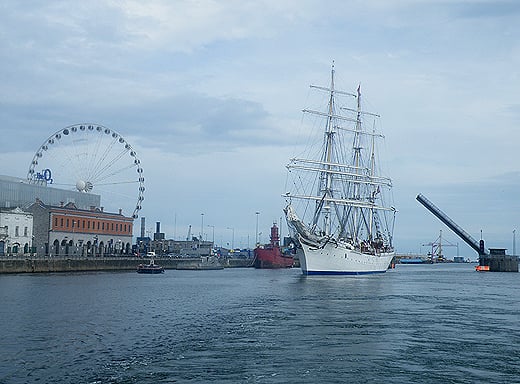
Photo: Jehan Ashmore
Dunmore East Bids TallShips Farewell
As the Russian 'A' class Mir passed the LE Aoife off Dunmore East in mid-morning, the largest tall ship of the festival headed the start of the Parade of Sail, writes Jehan Ashmore.
Crowds left their cars in fields outside Dunmore East and descended into the harbour and surrounding headlands to witness the highlight of the four-day festival. Adding to the scene were the numerous leisure-craft, yachts and intrepid kayakers that gathered to greet the procession which took some two hours to pass the fishing harbour.
No sooner had the fully-rigged ship Mir had slipped beyond the anchored naval vessel that the gaff schooner Johanna Lucretia, under full sail came closer into view. She was closely followed by the Ocean Youth Trust Scotland's Bermudan cutter Alba Explorer.

The Russian 'A' class Mir passing the LE Aoife off Dunmore East. Photo: Jehan Ashmore
Of all the 45 tallships participating the Columbian Navy's barque ARC Gloria presented the most colourful entrant. She proudly flew a large horizontal tricolor of yellow, blue and red representing the South American nation.
When it came to the turn of the Europa to pass the LE Aoife, the tug Bargarth gave a wonderful send-off with the traditional display of water jets shooting sky-high, nearly reaching the top of the three-masted barque.
Marking the tail-end of the parade was the Jubilee Sailing Trust's Lord Nelson, another barque that departed the estuary with the Hook Head Lighthouse forming a majestic backdrop.
At this stage several of the large tallships could be seen on the far horizon in preperation to the start of the first race leg of this years Tall Ships Races....next port of call Greenock!
- Waterford
- ship
- Dunmore East
- Lord Nelson
- Waterford Estuary
- LE Aoife
- Sail Training International
- Jubilee Sailing Trust
- Tug
- Hook Head
- Tall
- JOHANNA LUCRETIA
- TallShips
- Waterford Harbour
- JST
- Europa
- Fullyrigged ship
- STI
- ARC Gloria
- Hook Head Lighthouse
- Mir
- Gaff schooner
- Ocean Youth Trust Scotland
- Bermudan cutter
- Alba Explorer
- Columbian Navy barque
- Bargarth
- Fastnet Shipping
It's Official: Third Time Tallships for Waterford
Scenes of the tallships moored alongside the north and south quays and the surrounding festivities are captured by Gary O'Mahony. SCROLL DOWN FOR PICS.

The Columbian Navy's Sailing Training Ship ARC Gloria. Photo: Jehan Ashmore
This is the second year in which the city has been the host port of the Tall Ships Race and the prestigious event is to return for a third time. The next occasion has not been confirmed but it would be several years away according to Sail Training International, the organisers of the famous race.
Lord Nelson Heads for Waterford
As the Tall Ship STS Lord Nelson nears Carnsore Point off Wexford this evening the barque will be one of the many vessels participating in the Waterford Talls Ships Races Festival, writes Jehan Ashmore.
Joining Lord Nelson are three other UK entrants, they are the Jean de la Lune, Pelican of London and Royalist now celebrating her 40th anniversary. Together these tallships belong to the 'A' class vessels, the largest of the tallships. The impressive array of A class vessels includes four ships alone from The Netherlands with the Astrid, Eendracht, Europa and Wylde Swan, a schooner built in 1920.
From Norway is the fully rigged tallship Christian Radich and Sorlandet. The Poles are coming with their Pogoria. Neighbouring Russia are sending their impressive 108m long Mir which has 26 sails and has a 200-strong crew though the 1987 built vessel can be sailed with just 30. The final A class entrant is from outside Europe, the Columbian 1,300 tonnes Gloria, a three-master of over 60 metres long.
In addition to this exciting line-up are the 'B' and 'C' class which in total brings 45 tallships of all shapes and sizes to the quays of the River Suir. The crystal city will be host to over 1,000 trainess and over 400 professional crew who will take part in the colourful 'Crew Parade' held on Friday. For a full list of tallships and accompanying photos go to www.waterfordtallshipsrace.ie/the-race/the-tall-ships/
The spectacle of the festival will culminate in the early hours of Sunday when the fleet departs the city and heads downriver with a 'Parade of Sail' in the estuary of Waterford Harbour. As the tallships pass offshore of Dunmore East, this will mark the start of the first race-leg to Greenock.
The famous race is organised by Sail Training International (STI) a charity established to harness sail training to develop and educate young people, regardless of nationality, culture, religion, gender or social background.
The STI can trace its roots with the creation of the Sail Training International Race Committee which organised the first race of sail training tall ships in 1956. Their website is www.sailtraininginternational.org/
100 Days to Waterford's Tall-Ships Festival
is to draw 500,000 visitors from home and abroad. The festival is to be presented by Szczecin and organised by the Sail Training International.
Over 70 of the worlds tall-ships of all shapes and sizes will sail up the River Suir to take up residence on both sides of Waterford's city centre quays, where a major meeting of over 1,500 trainee sailors stretching from far and distant shores are to congregate.
One of the attending Class 'A' fully rigged ships, Christian Radich, which was built in 1937, incidentally provided sail-training opportunities for Irish trainees in an arrangement between her Norwegian owners and Coiste an Asgard. The sail-trainee agreement in 2009 followed the sinking of Coiste an Asgard's brigantine the Asgard II in the previous year. This was to be the last season of the state-owned sail training agency which was axed in the 2009 budget.
Another 'A' lister is the UK flagged Royalist, a brig built by Groves and Gutteridge in Cowes, Isle of Wight to a design by Colin Mudie. The 40 year old brig was named by HRH Princess Anne in 1971 for the Sea Cadet Association. She may be small for an 'A' class at just 28-metres long but the vessel can easily be spotted with her distinctive black and white painted hull.
While one of the oldest vessels to participant is the 87 year-old Brixham built trawler Provident, which along with Leader, are the only 'sailing' survivors of a once numerous traditional North Sea fishing craft. The 95-foot vessel was built at Galmpton on the River Dart. In 1991 there was a major refit of the 85 tonnes craft which has since 1999 worked from Brixham as part of the Trinity Sailing Foundation.
The event which is billed as the largest Irish festival in 2011 also presents young Irish people to experience a once in a lifetime opportunity to set sail onboard a tall-ship. The opportunity is open to those aged 16 or over by June 30 and are fit and active to be a trainee on the inaugural race leg from Waterford to Greenock (departing 3 July). For details click here.
On this date the eagerly awaited 'Parade of Sail' is set to depart the crystal city downriver on the Waterford Estuary and out into the open sea.
Looking for further reading on Tall Ships in Ireland? Click the links below:
Click this link to read all our Tall Ships Stories on one handy page
Previewing Ireland's Tall Ships 2011 Season
Can Ireland Get a New Tall Ship?
Will Sail Training Be Restored?
I am glad to see that efforts are being made to restore the national sail training programme, but less sanguine about reposing any confidence in the present Government to give practical assistance.
I talked a few weeks ago with the Irish Sailing Association's Chief Executive about their involvement in moves to establish a new sail training organisation to replace Coiste an Asgard, which the Government abandoned. Harry Hermon told me that the ISA had been examining the possibilities of what could be done. They were providing a forum which has now led to the setting-up of a steering group aimed at establishing a new organisation, Sail Training Ireland.
Sail Training International which organises the Tall Ships Races has given support. The Tall Ships Race will start from Waterford Port next year and is due into Dublin in 2012.
Nigel Rowe, Chairman of the international body, has expressed confidence that the current moves will result in a plan to continue sail training in Ireland. Sail Training International has awarded a bursary to the emerging Irish organisation, providing financial support for young Irish sailors in the 2011 and 2012 races.
The ISA working group says it will make a formal launch of its plans in the next few weeks. At present it is putting together a feasibility study and a business plan which will be presented to the Government in the New Year.
While the ISA move is welcome, I wonder about the value of presenting a plan to the existing Government which destroyed sail training, abandoned Asgard II on the seabed off France and used the insurance compensation money for purposes other than sail training.
I understand that other groups, who may differ with the ISA approach, have been planning their own moves in sail training and that the ISA decided to establish its position in public first.
It also has to be noted that there was criticism of the former Coiste an Asgard committee which did not make any moves in public to oppose the Government closure, on financial grounds, of the sail training programme.
It would be regrettable if differences delayed positive developments, but a united approach, involving the widest possible support to the restoration of sail training would be best.
• This article is reprinted by permission of the EVENING ECHO newspaper, Cork, where Tom MacSweeney writes maritime columns twice weekly. Evening Echo website: www.eecho.ie

































